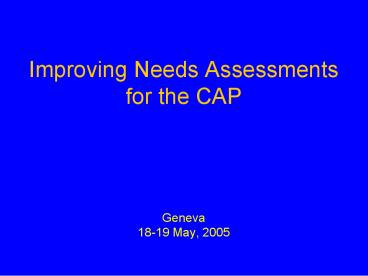Improving Needs Assessments for the CAP - PowerPoint PPT Presentation
1 / 16
Title:
Improving Needs Assessments for the CAP
Description:
Chose to test it in Burundi and DRC. CDI picked it up. 2005: tests in Burundi, CDI, DRC, oPt, Uganda. Tested' GHD General Principle 6: ... – PowerPoint PPT presentation
Number of Views:40
Avg rating:3.0/5.0
Title: Improving Needs Assessments for the CAP
1
Improving Needs Assessments for the CAP
- Geneva
- 18-19 May, 2005
2
- Background
- Lessons learned
- Learning lessons
- Conditions for success
3
1. Background
- IASC agreed that we need to improve coordination
of assessments and assessment data - Tasked WHO/UNICEF with taking lead
- Conclusions
- Assessments done but not well coordinated info
from them not systematically compiled, or
analysed across countries - Developed tool to agree on minimum data to be
collected, analysed and presented - IASC CAP SWG then Workshops Dec 2003 Feb 2005
4
Tool NAF
- How results of individual assessments can be
consolidated analysed in consistent format
before preparing CHAP. - Focus on better coordinated and more joint
assessments. - Combines evidence and judgment to reflect on
humanitarian needs
5
Link with GHD
- Chose to test it in Burundi and DRC
- CDI picked it up
- 2005 tests in Burundi, CDI, DRC, oPt, Uganda
- Tested GHD General Principle 6
- Allocate humanitarian funding in proportion to
needs and on the basis of needs assessment - Shared responsibility agencies/donors
6
2. Lessons learned in2004
7
Positive
- Useful to motivate debate on priorities needs
- Major progress in some sectors overall in CDI
- Helped to evaluate information strengths gaps.
- Collaboration between UN NGOs and donors
- Shared understanding of the added value
- Active involvement of some donors
- Main success factor was sending additional staff
- Timing good - useful inputs to the CHAP workshops
8
Negative
- Buy-in at field level mixed - not all sectors
produced overviews - Underestimated required investment in staff time
- NAF considered too complex not user friendly.
- Misunderstanding of purpose expected outcomes
- Many unresolved questions on technical and
analytical aspects to translate findings to needs
9
3. Learning lessons
- Focus on clarity and implementation, less on tool
(which has since then been thoroughly revamped).
- Expand to 5 field locations (done)
- Workshop - UN agencies and NGOs from field,
donors and Red Cross Movement main focus
clarity planning for implementation - Wanted to ensure ownership from field and address
issue of why, what, how.
10
Why?
- To enable HCs/CTs to reach a common understanding
of humanitarian needs and set priorities. - This will help develop strategies and programmes
that address priorities - and how much it will cost
11
Incentives?
- Professionalism
- Accountability
- Advocacy
12
What?
- A tool to organise and analyse information on
needs
13
How?
- Implementation plans
- Step by step approach of what is needed by when
and by whom to make this happen - Draft for each country to be finalised in field
14
Draft Needs Assessment Analysis implementation
plan at country level 2005
15
4. Conditions for success
- Need HC, OCHA, and agencies and NGOs
- Ownership at field level
- Organised implementation and monitoring
- Resource implications (staff money).
- Donors political support and involvement key.
Pick a sector. Help reinforce messages (stress
importance fund according to priority needs). - First focus on each country, then on need across
countries.
16
- THANK
- YOU































